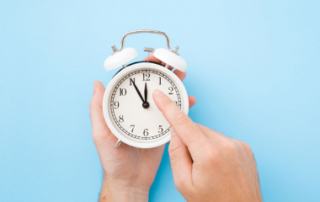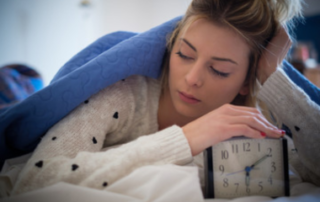Daylight Saving Time
The American Academy of Sleep Medicine supports the elimination of daylight saving time. A change to permanent standard time is best aligned with human circadian biology and has the potential to produce beneficial effects for public health and safety.
AASM Daylight Saving Time Position
In October 2023, the American Academy of Sleep Medicine published an updated daylight saving time position statement. The statement was endorsed by 20 medical, scientific, and civic organizations.
What is the AASM position on daylight saving time?
It is the position of the AASM that the U.S. should eliminate seasonal time changes in favor of permanent standard time, which aligns best with human circadian biology. Current evidence supports the distinct benefits of standard time for health and safety, while also underscoring the potential harms that result from seasonal time changes to and from daylight saving time.
What are the negative health and safety effects of daylight saving time changes?
The annual change from standard time to daylight saving time is associated with increased risk of heart attacks and stroke. There are increased hospital admissions due to atrial fibrillation. There also is an increase in emergency room visits and missed medical appointments. Traffic accidents increase in the first few days after the change from standard time to daylight saving time. The spring and fall time changes also have been associated with mood disturbances and suicide.
How do daylight saving time changes affect our sleep?
During daylight saving time, we tend to go to bed and fall asleep later at night, resulting in sleep loss. The spring and fall time changes also can disrupt our sleep schedule and have a negative effect on the quality of our sleep. The daylight saving time changes can be especially problematic for any populations that already experience chronic insufficient sleep or other sleep difficulties. Populations at greatest risk include teenagers, who tend to experience chronic sleep restriction during the school week, and night shift workers, who often struggle to sleep well during daytime hours.
Why is daylight saving time bad for our sleep?
Light and darkness are the most powerful timing cues for alertness and sleepiness in the human body. We are more alert in the daytime when there is bright sunlight, and we are sleepier at night when there is darkness. Our daily sleep/wake rhythm closely follows the 24-hour light/dark cycle. This is called our “circadian rhythm.” The one-hour time shift during daylight saving time results in less exposure to light in the morning and greater exposure to evening light relative to typical sleep and work schedules. As a result, we tend to go to bed and fall asleep later, resulting in chronic sleep loss. Daylight saving time causes ongoing misalignment between our sleep/wake rhythm and the light/dark cycle, also called “social jet lag.”
Why is standard time better for our sleep than daylight saving time?
Standard time is best aligned with human circadian biology. During standard time, your body clock, the timing of sunrise and sunset, and local clock time are more in sync than during daylight saving time. This alignment enables most people to sleep better at night and feel more alert during the day.
Is daylight saving time like jet lag?
No, daylight saving time and jet lag are different. Jet leg, caused by a change in time zone, involves a temporary mismatch between your body clock and the local clock time. It is temporary because the timing of sunrise and sunset in your new time zone is different from your old time zone; the sun rises and sets earlier or later than in your previous location. Therefore, your body is able to adjust to the local clock time because of the light cues provided by the sun. In contrast, during daylight saving time, the local clock time changes, but the timing of sunrise and sunset remains the same. This causes ongoing misalignment between your body clock, the sun time, and local clock time.
Does daylight saving time give us more sunlight?
There are common misconceptions about daylight saving time and standard time. People often like the idea of daylight saving time because they think it provides more light. (People often equate daylight saving time with “summer time.”) In the same way, people may dislike the concept of standard time because they think it provides more darkness. (They equate standard time with “winter time.”) The reality is that neither one provides more light or darkness than the other; it is only the timing of light and darkness that changes.
Does the U.S. public support ending daylight saving time changes?
An AASM survey of more than 2,000 U.S. adults found that 63% support the elimination of seasonal time changes in favor of a national, fixed, year-round time, and only 11% oppose it.
Additionally, a 2025 Gallup poll found that 54% of Americans oppose daylight saving time, a significant decline from 73% support in 1999. The survey also revealed that 48% prefer standard time year-round, while 24% favor permanent daylight saving time and 19% support the current biannual clock changes.

How can I advocate to end daylight saving time?
Visit the AASM Action Center to contact your federal legislators.
Daylight Saving Time Transition Sleep Tips
The American Academy of Sleep Medicine provides these tips to help you minimize the impact of transitioning from standard time to daylight saving time and vice versa on your sleep. In the days leading up to the change to daylight saving time, you should:
- Get at least seven hours of sleep (for adults) or eight hours of sleep (for teens) per night before and after the time change. You can use the AASM’s bedtime calculator to identify an appropriate nightly bedtime.
- Gradually adjust your sleep and wake times. Shift your bedtime 15 to 20 minutes earlier each night for a few nights before the spring time change, or 15 to 20 minutes later each night for a few nights before the fall time change. (If you are experiencing chronic insufficient sleep, you should avoid shifting your bedtime later before the fall time change; you will benefit from getting an “extra” hour of sleep on the night when you “fall back” to standard time.)
- Adjust other daily routines — such as mealtimes — to match your new schedule prior to the time change.
- Set your clocks to the new time on Saturday evening, and go to bed at your normal bedtime.
- Use light and darkness to help your body adjust. In the spring, head outside for some sunlight on Sunday morning and dim the lights in the evening. In the fall, minimize light exposure until your target morning wake time. Adjusting your exposure to light and darkness will help set your body clock, which regulates the timing of sleep and alertness.
- Get plenty of sleep on Sunday night to ensure you’re rested and ready for the week ahead.
Daylight Saving Time Survey Results
The American Academy of Sleep Medicine has surveyed U.S. adults about daylight saving time:
Daylight Saving Time Press Releases
- New position statement supports permanent standard time
- AASM experts advocate for permanent standard time ahead of “fall back”
- American Academy of Sleep Medicine opposes permanent daylight saving time bill
- AASM statement on Senate passage of permanent daylight saving time bill
- AASM supports elimination of daylight saving time change, urges Congress to hold hearing
- Ditching the daylight saving time change for better sleep, health and safety
- American Academy of Sleep Medicine calls for elimination of daylight saving time
- Survey: 55% of US adults feel tired after spring daylight saving time transition
- When daylight saving time ends, 41% plan to ‘fall back’ to sleep
Additional Resources
Learn more about the science of daylight saving time
Learn more about the science of circadian rhythms, daylight saving time, and standard time on the website of the Society for Research on Biological Rhythms.
Watch a video series
Watch the video series, “The Science of Clock Change.” Created by the Save Standard Time organization, and supported by funding from the AASM Foundation, the 12-video series explores how clock change affects our lives.
Statements supporting permanent standard time
- American Medical Association | AMA calls for permanent standard time
- National Sleep Foundation | Permanent Standard Time: A Position Statement from the National Sleep Foundation
- Sleep Research Society | It is time to abolish the clock change and adopt permanent standard time in the United States: a Sleep Research Society position statement
- Society for Research on Biological Rhythms | Why Should We Abolish Daylight Saving Time?
About Daylight Saving Time
General information is provided below about the history and current practice of daylight saving time in the U.S. This information has been extracted from a daylight saving time report by the Congressional Research Service.
What is daylight saving time?
Daylight saving time is the period of the year between spring and fall when clocks in most parts of the United States are set one hour ahead of standard time.
When does daylight saving time begin?
Daylight saving time begins in the U.S. on the second Sunday in March.
When does daylight saving time end?
Daylight saving time ends on the first Sunday in November.
When did the U.S. first implement daylight saving time?
The United States established standard time zones and daylight saving time through the Calder Act, also known as the Standard Time Act of 1918. After World War I, Congress abolished summer daylight saving time at the federal level.
What federal laws govern daylight saving time?
U.S. time observance was clarified by the Uniform Time Act of 1966. It mandated standard time within the established time zones and specified the observance period for daylight saving time. U.S. law allows a state to exempt itself — or parts of the state that lie within a different time zone—from daylight saving time observance. U.S. law also authorizes the Department of Transportation to regulate standard time zone boundaries and daylight saving time. The time period for daylight saving time was changed most recently in the Energy Policy Act of 2005. Only Congress can change the length of the daylight saving time observance period.
Which U.S. states and territories do not observe daylight saving time?
The following states and territories do not observe daylight saving time: American Samoa, most of Arizona, Guam, Hawaii, the Northern Mariana Islands, Puerto Rico, and the Virgin Islands.
Has the U.S. ever had year-round daylight saving time?
Year-round daylight saving time has been implemented three times on a temporary basis in the United States. In 1918, during the first World War, daylight saving time was implemented as an energy-saving measure; however, it was quickly abolished at the end of the war. In 1942, Congress enacted a law to institute year-round daylight saving time, which became known as “War Time.” After the conclusion of World War II, Congress terminated daylight saving time, and War Time concluded in September 1945. During the 1973 oil embargo, Congress enacted the Emergency Daylight Saving Time Energy Conservation Act of 1973, which established a trial period of year-round daylight saving time, from January 1974 to April 1975. The trial period was amended, partially due to the unpopularity of year-round daylight saving time, to include four months of standard time from October 1974 to February 1975. When the trial period ended in 1975, the country returned to observing summer daylight saving time. Following the trial period, the National Bureau of Standards delivered a report to Congress. It found no significant energy savings from daylight saving time.
Daylight Saving Time Blogs
Sleep loss affects generosity, desire to help others
Why do we choose to help one another? There are [...]
Time to end seasonal time changes
As most of the U.S. prepares to return to standard [...]
Spring forward, sleep less: Teens and daylight saving time
A new study shows that high school students lose sleep [...]
Sleep tips to prepare for daylight saving time
It’s not your imagination that you feel sleepier after you [...]




